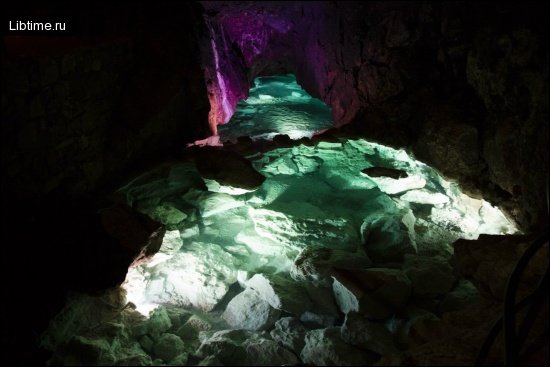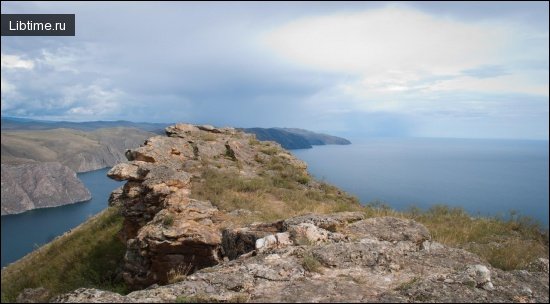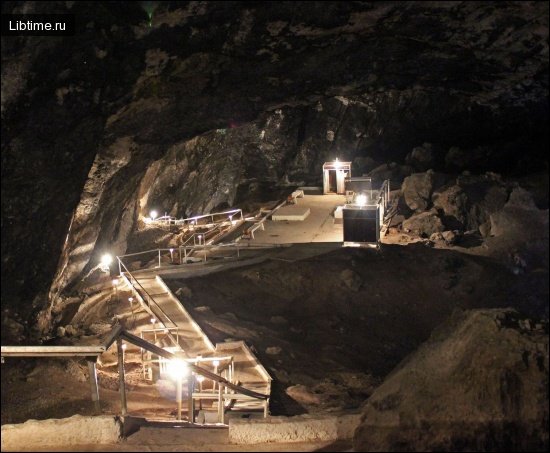Caucasus caves
Within the caving area of the Greater Caucasus there are three provinces: North Caucasian, East Caucasian and Gorno-Kolkhid. 
Karst caves confined to Jurassic gypsum and limestone are quite widespread. At present 142 caves have been described here, including 38 caves more than 100 m long.
The largest are Butkova I (7000 m long), Dezova (473 m), Bagovskaya VI (1900 m), Beslineaevskaya I (1800 m), Ammonitnaya (1669 m), Azishskaya (1280 m) and Neizma (1235 m).
A special position is occupied by Butkova I cave (total length of about 7000 m), located 7 km south-east of Novosvobodnaya station. It was formed in limestones of Jurassic age. The cave is a complex labyrinth of narrow and low passages, passing in some places into small grottoes.
Among the caves of the Caucasus is interesting Azishskaya cave (total length 1280 m), located on the north-western slope of the Azish-Tau ridge, 12 km from the village of Khamyshki. It was formed in Upper Jurassic dolomitized limestones.
The cave consists of several grottoes and passages connecting them. The largest grottoes reach 25 meters in length and 25 meters in height. A stream flows along the bottom of the main passage. Nate formations are widely developed. The air temperature is 10-12°. The East Caucasus Speleological Province is located in the northeastern part of the Greater Caucasus east of the Ardon River.
There are 35 caves explored here. The largest of them are Nyvzhin-leget (350 m long), Chaldybalskaya (150 m), Kara-Budakhkentskaya (135 m) and Usman-leget (100 m). The cave Nyvzjin-leget is located on the interfluve of the rivers Fiogdon and Gizeldon, 3 km east of the village Tagardon, on the northern slope of the spur of Khosh-Khararog.
The cave was formed in limestone. The entrance reaches 1.8 m in height and 10 m in length. The length of the cave is 350 m and the volume is 1500 m3. 
It is characterized by a very wide distribution of karst caves, many of which reach significant sizes. At present, more than 420 karst cavities have been explored here, including 96 caves over 100 meters long and 10 mines deeper than 100 meters.
The largest caves in the Caucasus include the Vorontsov system (8000 m long), the Novoafon cave (3285 m long), Abrskila (2500 m long), Tkibula-Dzevrula (1800 m long, 280 m deep), Kelasurskaya (length 1380 m, depth 100 m), Taroklde (1370 m), Shakuranskaya III (1300 m), Bolshaya Akhunskaya (1200 m), Okrodzhanashvili (1150 m), Varsina (960 m), Sataplia (890 m) and Shvilobisa (860 m).
The Vorontsovskayasystem includes mainly the caves Big Vorontsovskaya, Long and Labyrintovaya, located in the upper reaches of the Kudepsta River. The Big Vorontsovskaya Cave is a complex labyrinth of underground galleries and grottoes with a total length of 2218 meters.
Half a kilometer north of it is the entrance to the Labyrinth Cave, confined to the north-western periclinal end of the Vorontsovskaya anticline, composed mainly of Upper Cretaceous limestone.
The cave is 1920 m long and consists of a series of passages and grottoes. In some of the grottoes there are wells up to 15 m deep. Streams flow along the bottom of many passages. There is a waterfall 2 m high. There are three siphons in the cave, which are passable in the dry season.
Fluorescein staining method established that water enters the cave from the Kudepsta River, which is absorbed by the ponor at the contact of Upper Cretaceous limestone and palogenic marl.
From the Labyrinth Cave it enters the Big Vorontsovskaya Cave through cracks, which is also proved with the help of fluorescein.
The Dolgaya Cave (1560 m long) is located one kilometer east of Bolshaya Vorontsovskaya. Its entrance resembles a well, passing into a 20-meter long spiral descent that leads to horizontal galleries. A stream flows along the bottom of the cave, there are siphons.
Abrskila Cave

The height of the largest one - the Grotto of Giants - reaches 40 - 50 m. Almost everywhere at the bottom of the corridor and grottoes there are clay deposits in which the underground river Achkhitizgo formed three terraces.
The ceiling of the corridors and grottoes is richly decorated with stalactites. There are several lakes in the cave, framed by calcite crust.
Snow abyss
The deepest karst cavities of the Soviet Union are located in the Gorno-Kolkhid province. Among them there are Snezhnaya (depth 770 m), Geographic (510 m), Nazarovskaya (500 m), Oktyabrskaya (400 m), Velichivnaya (320 m) and Shkolnaya (300 m).
There are five grottoes in the Snow Abyss. The largest of them is the Big Grotto, which reaches 120 m in length and 70 m in width. In the middle part of it rises an ice hill 15 m high. 
1 - Ice grotto; 2 - Obvalny grotto; 3 - Bolshoy grotto; 4 - Maly grotto; 5 - Korallitovy well; 6 - Bolshoy well; 7 - Universitetsky grotto; 8 - Vodopadny brook; 9 - underground river. Nate formations are especially beautiful in the Corallite well.
In the Vertical Labyrinth, consisting of many passages developed along tectonic cracks, a stream appears, which at first has an intermittent distribution. Below it turns into a significant stream with a flow rate of 20-30 l/sec, which in some places forms bizarre waterfalls up to 8 m high.
At a depth of 700 meters at the exit from the gallery Vodopadnoy stream flows into a large underground river, the flow rate of which reaches 500 liters / sec. This river rushes down a stepped passage 2-6 m wide and disappears in a stone rubble, which we have not been able to pass yet.


